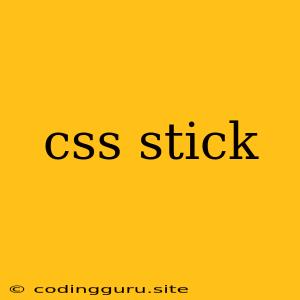Understanding CSS position: sticky
The position: sticky property in CSS is a powerful tool that combines the best of both position: relative and position: fixed properties, offering a way to create elements that stick to a specific point on the page while scrolling. It allows elements to maintain their position within the normal document flow until a certain threshold is met, at which point they "stick" to the viewport.
Why Use position: sticky?
Here's a breakdown of why you might want to use position: sticky:
- Improved User Experience: It enhances user experience by making elements always accessible while scrolling, preventing them from disappearing off-screen.
- Flexible Positioning: It offers the flexibility of both
position: relativeandposition: fixed, allowing for precise control over how an element behaves during scrolling. - Efficient Implementation: It's easier to implement compared to using JavaScript for similar effects.
How Does position: sticky Work?
- Initial Position: The element is positioned normally in the document flow just like any other element.
- Scrolling Threshold: You define a specific threshold (using
top,bottom,left, orrightproperties) when the element should "stick." This threshold defines the point where the element transitions from its normal position to the sticky state. - Sticky Behavior: Once the scroll position reaches the specified threshold, the element starts to "stick" to the viewport. It will remain visible as the user continues to scroll, but will stay within the boundaries of its containing block.
Key Properties to Use with position: sticky
1. top, bottom, left, right: These properties determine the position of the element relative to the viewport when it becomes sticky.
2. z-index: This property is crucial for controlling the stacking order of elements, ensuring that your sticky element doesn't get hidden behind other elements.
3. contain: The contain property can improve performance by telling the browser that the element's layout, painting, and size are all independent of its surroundings.
Example: Creating a Sticky Navigation Bar
.header {
position: sticky;
top: 0;
background-color: #f0f0f0;
padding: 10px;
z-index: 1;
}
This CSS code defines a .header element as sticky and sets its position at the top of the viewport (top: 0). As you scroll down, the header will "stick" to the top of the screen, providing a consistent navigation bar.
Tips and Best Practices
- Understand the containing block: The element's behavior is dependent on its containing block. Ensure the containing block has a defined height to prevent unexpected results.
- Use
z-indexwisely: Prioritize sticky elements usingz-indexso they don't get hidden behind other elements on the page. - Be mindful of browser support: While
position: stickyis widely supported by modern browsers, there are some limitations in older browsers. Consider using a fallback mechanism for better compatibility.
Conclusion
position: sticky provides a powerful and flexible way to create engaging and intuitive user experiences. It allows for elements to "stick" to specific points on the page while scrolling, enhancing navigation, content accessibility, and overall user engagement. By understanding its properties and best practices, you can effectively utilize this CSS property to elevate the design and functionality of your websites and web applications.
